NCERT Solutions for Class 7 English Unit 2 Animals, Birds, and Dr. Dolittle
Let us do these activities before we read (Page 43)
Q1: Do you have a pet or a domestic animal? If yes, why? If not, why not? How do people usually spend time with a pet or domestic animal? Share your thoughts with your classmates and the teacher.
Ans:
If yes, why?
Yes, I have a pet. I have a dog. I keep a pet because pets are friendly, playful, and loving. They make me feel happy and keep me company when I am alone.
(OR)
If not, why not?
If someone does not have a pet, it may be because of lack of space, busy schedules, or health reasons. Still, people can enjoy being around animals by visiting farms, friends’ pets, or helping stray animals.
How do people usually spend time with a pet or domestic animal?
People usually spend time with their pets or domestic animals in many ways. They play with them, take them for walks, feed them, and look after their health. Pets are also like family members, and spending time with them gives us joy and teaches us responsibility.
Q2: You must have read stories where animals and birds talk. If you had a chance to communicate with an animal or a bird, who would you like to speak to and why? Share your thoughts with your classmates and the teacher.
Ans: I would like to talk to a parrot because it can repeat words.
(OR)
I would like to talk to a dog to know what it feels when it is happy or sad.
Q3: If we closely observe the body language of animals and birds, we can understand what they want to tell us. Work in pairs and study the pictures given below. Find out what emotions these animals and birds are trying to convey. Share your observations with your classmates and the teacher.

Ans:
- Duck (Picture 1)
- Emotion: Angry or upset
- Body Language: Wings spread, eyebrows down.
- Observation: The duck looks like it is angry.
- Cat (Picture 2)
- Emotion: Scared or frightened
- Body Language: Arched back, wide eyes, tail up and puffed.
- Observation: The cat looks scared.
- Dog (Picture 3)
- Emotion: Happy and playful
- Body Language: Tongue out, tail up, ears up.
- Observation: The dog looks cheerful and friendly.
- Cockatoo (Bird in Picture 4)
- Emotion: Curious or alert
- Body Language: Standing tall, one foot up.
- Observation: The bird looks curious or is paying attention to something.
These body language cues help us understand how animals might be feeling, even if they cannot speak like humans.
Let us discuss (Page 46)
QI: Complete the following sentence by selecting a suitable reason. The Cat's-food-Man suggests to Doctor Dolittle that he should become an animal doctor because he believes that Dolittle _______________
1. earns less fee by treating human patients
2. enjoys the company of animals as they speak less
3. dislikes spending time with human patients
4. knows more about animals than the local veterinarians
Ans: 4. knows more about animals than the local veterinarians
The Cat's-food-Man says, "you know all about animals—much more than what these vets here do", showing he believes Dolittle is better than local veterinarians.
QII: Fill in the blanks by choosing the suitable option given in the brackets.
Doctor Dolittle reacts to Polynesia's information about animal languages with both excitement and ___________ (certainty/curiosity). He rushes to _____________ (write/memorise) the bird words she provides and is interested in learning more.
Ans: curiosity; write
The story states, "Tell me some more,' said the Doctor, all excited, showing excitement and curiosity. He rushes to get a book and pencil to "write it down," confirming he writes the words.
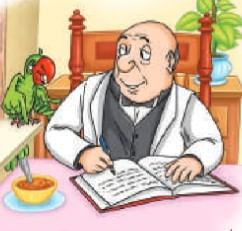 QIII: Do you think Doctor Dolittle would be famous as an animal doctor? If yes, why? If not, why not?
QIII: Do you think Doctor Dolittle would be famous as an animal doctor? If yes, why? If not, why not?
Ans: Yes, Doctor Dolittle would be famous as an animal doctor because he could understand and talk to animals. No other doctor could do that. As birds flew all over the world they would spread this news globally.
Let us discuss (Page 49)
QI: What became a common sight in Puddleby after Doctor Dolittle started treating animals?
1. Humans talking to farm animals
2. Farm animals wearing glasses
3. Farm animals learning bird language
4. Birds riding atop farm animals
Ans: 2. Farm animals wearing glasses
The story says, "soon it became a common sight to see farm animals wearing glasses in the countryside, round Puddleby", after Dolittle prescribed glasses for a horse.
QII: What challenges do you think Doctor Dolittle might face if more and more animals come to him for help? How might he overcome these challenges to ensure that he provides good treatment?
Ans:
Challenges:
- Doctor Dolittle might face the problem of too many animals coming at once.
- It can be hard to treat all of them quickly.
Solutions:
- He can make special doors for different animals to organize them.
- He can also take help from others or work carefully to treat every animal well.
QIII: Arrange the following events in correct order according to the story. Two have been done for you. Share your answers with your classmates and the teacher.
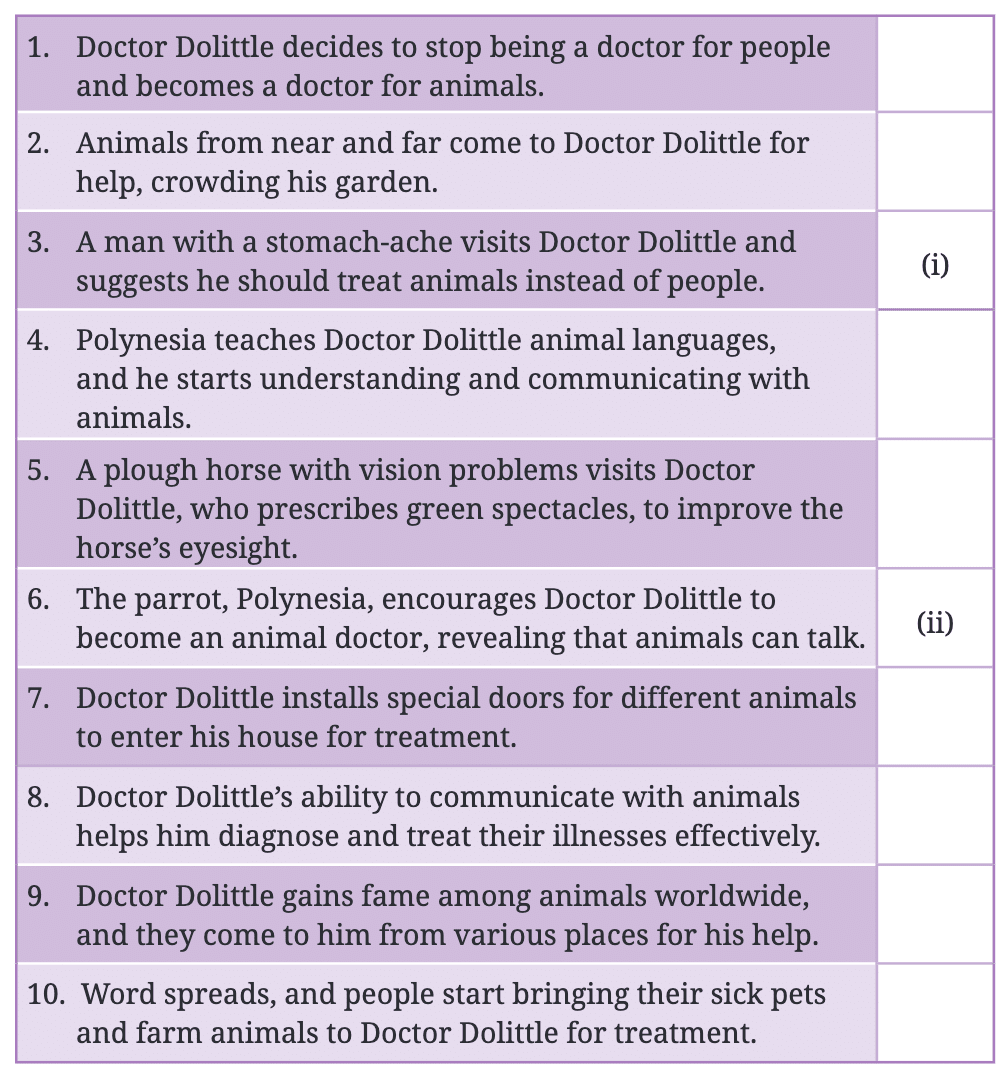
Ans:
1. A man with a stomach-ache visits Doctor Dolittle and suggests he should treat animals instead of people. (This is already marked as (i))
2. The parrot, Polynesia, encourages Doctor Dolittle to become an animal doctor, revealing that animals can talk. (This is already marked as (ii))
3. Doctor Dolittle decides to stop being a doctor for people and becomes a doctor for animals.
4. Polynesia teaches Doctor Dolittle animal languages, and he starts understanding and communicating with animals.
5. A plough horse with vision problems visits Doctor Dolittle, who prescribes green spectacles to improve the horse’s eyesight.
6. Doctor Dolittle installs special doors for different animals to enter his house for treatment.
7. Doctor Dolittle’s ability to communicate with animals helps him diagnose and treat their illnesses effectively.
8. Word spreads, and people start bringing their sick pets and farm animals to Doctor Dolittle for treatment.
9. Animals from near and far come to Doctor Dolittle for help, crowding his garden.
10. Doctor Dolittle gains fame among animals worldwide, and they come to him from various places for his help.
Let us think and reflect (Page 50)
QI. Read the extracts given below and answer the questions that follow.
1. “If I say, ‘Polly wants a cracker’, you understand me. But hear this: Kaka oi-ee, fee-fee?”
“Good Gracious!” cried the Doctor. “What does that mean?”
“That means, ‘Is the porridge hot yet?’—in bird language.”
“My! You don’t say so!” said the Doctor. “You never talked that way to me before.”
“What would have been the good?” said Polynesia, dusting some cracker crumbs off her left wing. “You wouldn’t have understood me if I had.”
(i): Complete the sentence by choosing the correct option. In the line, "Good Gracious!" cried the Doctor, the expression 'Good Gracious' can be replaced by______!
A. bravo
B. gosh
C. alas
D. hurray
Ans: B. gosh
"Good Gracious" expresses surprise, as does "gosh."
The Doctor is surprised to learn bird language. "Bravo" (praise), "alas" (sadness), and "hurray" (joy) do not fit.
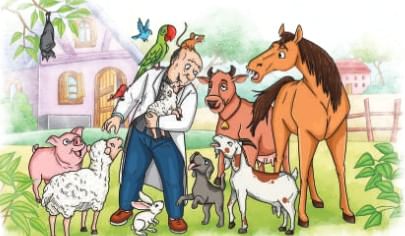 (ii): Why had Polynesia never used bird language with the Doctor earlier?
(ii): Why had Polynesia never used bird language with the Doctor earlier?
Ans: This is because she knew the doctor wouldn’t have understood it.
Polynesia says, "You wouldn’t have understood me if I had", as he didn’t know bird language before.
(iii): Identify whether the following statement is true or false.
Polynesia had been munching on a food item while talking to Doctor Dolittle.
Ans: True
The story mentions Polynesia "dusting some cracker crumbs off her left wing", indicating she was eating crackers.
(iv): How did Doctor Dolittle feel according to the extract?
A. anxious
B. surprised
C. angry
D. relaxed
Ans: B. surprised
The Doctor’s reactions like "Good Gracious!" and "My! You don’t say so!" show he is surprised by Polynesia’s revelation about bird language.
2. “I would like a pair like yours,” said the horse—“only green. They’ll keep the Sun out of my eyes while I’m ploughing the field.”
“Certainly,” said the Doctor. “Green ones you shall have.”
“You know, the trouble is, Sir,” said the plough horse as the Doctor opened the front door to let him out—“the trouble is that anybody thinks she can doctor animals— just because the animals don’t complain. As a matter of fact, it takes a much cleverer man to be a really good animal doctor than it does to be a good people’s doctor.”
(i): Choose a word from the extract to complete the analogy.
digging: flower bed:: ______ : field
Ans: ploughing
The horse says, "While I’m ploughing the field".
Digging is an action done in a flower bed, and ploughing is an action done in a field.
(ii): Choose the correct word to complete the sentence. Doctor Dolittle’s attitude in the extract is
A. respectful
B. sentimental
C. understanding
D. careful
Ans: C. understanding
The Doctor listens to the horse’s need for glasses and agrees, saying, "Of course—of course", showing he understands the horse’s problem.
(iii): Complete the sentence with an appropriate reason.
Based on the extract, we can conclude that doctors take animals for granted because ________.
Ans: They think animals do not complain or express pain like humans do.
The horse says, "anybody thinks he can doctor animals—just because the animals don’t complain", suggesting doctors assume animals are easy to treat since they don’t speak.
(iv): Do you agree with the concluding sentence of the extract? Why/why not?
Ans: Yes, I agree. Treating animals is harder because they cannot speak or explain their pain. A good animal doctor must understand them well and be kind and smart.
QII. Answer the following questions.
1: How can we say that Polynesia was a good trainer of animal language?
Ans: Polynesia was a good trainer because she not only knew the animal languages herself, but she also taught Doctor Dolittle how to speak and understand them. Because of her help, the Doctor was able to treat animals better.
2: Explain how Doctor Dolittle gave equal and individual attention to each animal who came to him for treatment.
Ans: Doctor Dolittle built special doors for different animals so they could enter his house easily. He also treated every animal kindly and carefully. Even the mice had their own little tunnel, showing that he cared for all animals, big or small.
3: How does Doctor Dolittle’s readiness to follow the parrot’s advice highlight the importance of listening to different viewpoints?
Ans: Doctor Dolittle listened to Polynesia, even though she was a bird. He did not ignore her. By following her advice, he discovered he could talk to animals and help them. This shows that listening to others, even if they are different, can bring great ideas and changes.
4: Which qualities of Doctor Dolittle made him famous among the animals? Explain with evidence from the text.
Ans: The qualities of doctor that made him famous were
1. Communication: He learned animal languages, allowing him to understand their problems.
2. Care: He prescribed glasses for a horse, solving its blindness.
3. Organisation: He made special doors for different animals, making treatment easier. These qualities made animals trust him.
5: What changes do you think would happen in the world if people suddenly gained the ability like Doctor Dolittle, to understand and communicate with animals?
Ans: People would treat animals better, understanding their needs and pain. Vets would diagnose problems easily, like Dolittle did with the horse. Animals might live happier lives, and humans would respect nature more.
Let us learn (Page 52)
I. Read the following words from the text.
Cat’s-food-Man, bird language, flowerpots
Are all the words that are combined to form another word written the same way?
Compound words are formed by combining two words of different parts of speech to create a new word that has an entirely new meaning. They are of three types─hyphenated (Cat’s-food-Man), open compound words (bird language) and closed compound words (flowerpots).
Complete the following table correctly by choosing words from the box given below.

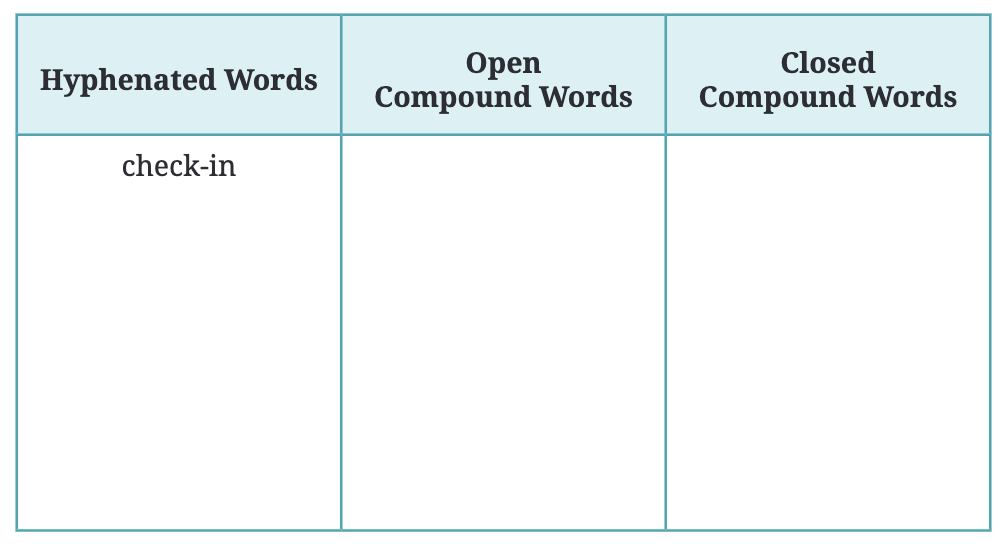
Ans: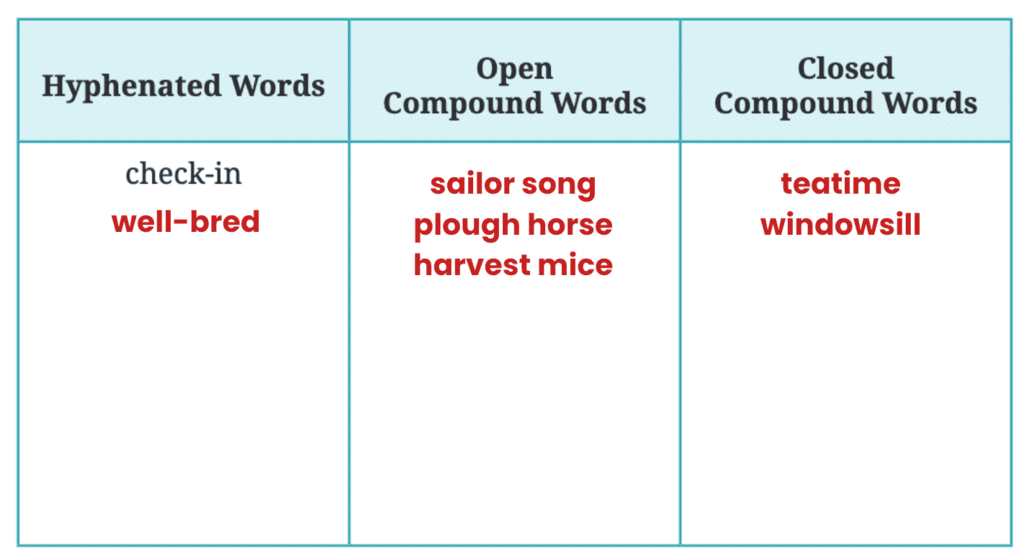
Explanation:
- Hyphenated: Words joined by a hyphen (-).
- Open: Words written with a space.
- Closed: Words written as one word with no space.
QII: Create compound words from the table given below.
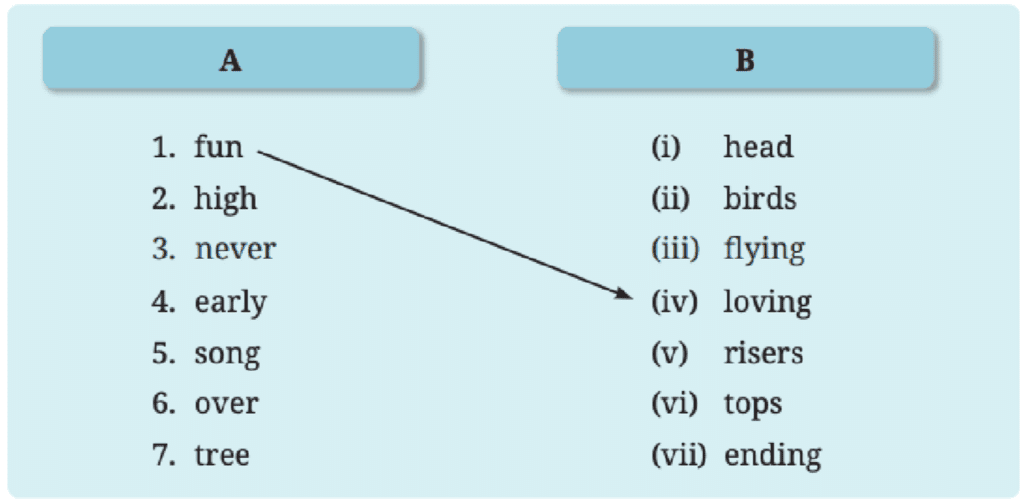
Ans:
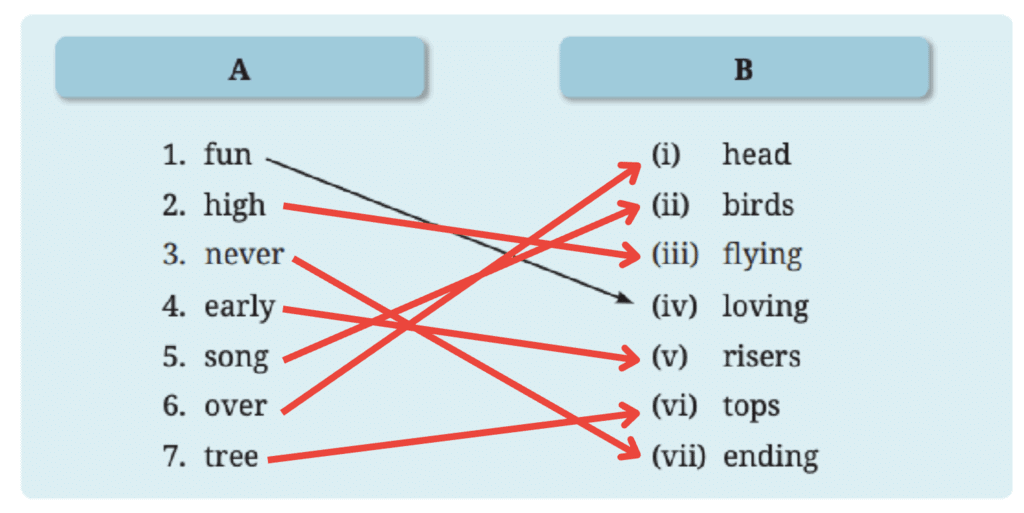
Now, complete the paragraph with suitable compound words from the table. An example has been done for you.
After being treated by Doctor Dolittle, the A. fun-loving dolphins danced playfully in his sanctuary. The B. _______________ chatter of monkeys echoed through the C. _______________, their ailments cured. D. ______________ eagles soared gracefully E. _______________ their health restored. F. _______________ among the G. _______________ chirped joyfully from the branches. All creatures were happy with Doctor Dolittle’s care.
Ans: After being treated by Doctor Dolittle, the A. fun-loving dolphins danced playfully in his sanctuary. The B. songbirds’ chatter of monkeys echoed through the C. overhead, their ailments cured. D. High-flying eagles soared gracefully. E. Never-ending their health restored. F. Early risers among the G. treetops chirped joyfully from the branches. All creatures were happy with Doctor Dolittle’s care.
QIII: Underline the names of animals that are hidden in the sentences given below. Clues are given within the brackets.
1. Dr. Dolittle was eating oatmeal for his breakfast. (a farm animal)
Ans: goat
2. Old ladies began to bring him their pets. (an insect)
Ans: ant
3. The author sees the connection between humans and animals. (a farm animal)
Ans: horse
4. The three baby dinosaurs are from ice age. (field animal)
Ans: mice
5. The patients who came late didn’t know where to go. (ship of the desert)
Ans: camel
QIV: Read the following sentence from the text. Study the highlighted words.
But that stupid man over the hill never even looked at my eyes.
The highlighted words spell and read the same backwards too.
A word, phrase, or sequence that reads the same backwards as forwards is a palindrome.
Some of the common palindromes include ‘Was it a car or a cat I saw?’, ‘Madam, I’m Adam’ and ‘A man, a plan, a canal—Panama’.
Read the sentences below and identify the palindrome words and sentences.
1. Step on no pets.
2. Naman saw a racecar at the show.
3. Nitin speaks in Malayalam.
4. The engineer used a rotator to check the surface level.
5. The pilot relied on the radar to navigate safely.
6. Eva can I see bees in a cave?
Ans:
- “Step on no pets.”
- This whole sentence is a palindrome.
- “Naman saw a race car at the show.”
- Naman (reads the same backwards)
- race car (reads the same backwards, ignoring the space)
- “Nitin speaks in Malayalam.”
- Nitin (palindrome name)
- Malayalam (palindrome word)
- “The engineer used a rotator to check the surface level.”
- rotator (palindrome word)
- level (Palindrome word)
- “The pilot relied on the radar to navigate safely.”
- radar (palindrome word)
- “Eva can I see bees in a cave?”
- This whole sentence is a palindrome (ignoring spaces and punctuation).
Now, create your own palindrome and share it with your classmates and the teacher.
Ans:
Words:
- level
- noon
- radar
- civic
- pop
- wow
- deed
- dad
- refer
Short Sentences:
- Madam, in Eden, I’m Adam.
- A Santa at NASA.
- Was it a rat I saw?
- Do geese see God?
- Never odd or even.
- No lemon, no melon.
QV: Underline the verbs and identify the tense form in the following sentences from the text.
1. He is asking you a question.
2. Oh, there are plenty of animal doctors.
3. I am going blind in one eye.
4. … the trouble is that anybody thinks he can doctor animals.
Ans:
- He is asking you a question. (Present continuous)
- Oh, there are plenty of animal doctors. (Simple present)
- I am going blind in one eye. (Present continuous)
- … the trouble is that anybody thinks he can doctor animals. (Simple present)
QVI: Read the following sentences from the text.
- That man’s (man has) got sense.
- Can’t you see that it has stopped raining?
In the first sentence the verbs, ‘has got’ denote an action that is relevant at the time of speaking. In the second sentence, the verbs‘has stopped’ denote an action that is recently completed.
We use present perfect tense to indicate:
• a recently completed action
• an action that started in the past and is relevant even at the moment of speaking
• an action in the past where the focus is on the action and not on the time of occurrence (but relevant at the time of speaking)
Structure of Present Perfect Tense:has/ have + V3 (past participle)
Fill in the blanks using the correct form of verbs (present perfect) given within brackets.
Since becoming an animal doctor, Doctor Dolittle 1. _________(learn) to communicate with all animals and birds. He 2. _________ (treat) countless farm animals and pets with care.The parrot, Polynesia, 3. _________ (teach) him bird-language, and he 4. _________ (write) books about his adventures. Many people 5. _________ (bring) their sick animals to his door. Over the years, Dolittle 6. _________ (become) renowned worldwide for his unique abilities.
Ans:
- has learned
- has treated
- has taught
- has written
- have brought
- has become
Let us listen (Page 55)
I) You will listen to an announcement. As you listen, state whether the following statement is true or false. (Transcript for the teacher on pg. 88)
Statement: Dr. Dolittle’s new clinic presents an offer of free medicines.
Transcript:
Greetings and attention everyone! We are excited to announce the opening of Dr. John Dolittle’s new clinic in the town of Woodstock. The clinic is located at 12, Rose Lane. It will be open Monday to Friday from 9 a.m. to 5 p.m. Special timings for birds are on Saturdays from 11 a.m. to 2 p.m. Dr. Dolittle is renowned for his ability to communicate with animals and shall ensure that they receive the best care possible. All animals are welcome, from horses and cows to pets and wild animals. For the best veterinary care, visit Dr. John Dolittle’s new clinic in Woodstock. Thank you.
Ans: False - The announcement does not mention an offer of free medicines at Dr. Dolittle’s new clinic. It focuses on the clinic’s opening, location, hours, and Dr. Dolittle’s ability to care for animals.
II) You will listen to the announcement again. As you listen, complete the details given below with one or two exact words you hear.
1. The new clinic is located in the town of ______________.
2. The address is 12, ______________ Lane.
3. The clinic is open Monday to Friday from ______________ a.m. to 5 p.m.
4. Special timings for ______________ are on Saturdays from 11 a.m. to 2 p.m.
5. Dr. Dolittle will ensure that animals get the ______________.
6. All animals—horses, cows, ______________, wild animals, and others are welcome.
Ans: Based on the provided transcript of the announcement, here are the completed details with one or two exact words:
- The new clinic is located in the town of Woodstock.
- The address is 12, Rose Lane.
- The clinic is open Monday to Friday from 9 a.m. to 5 p.m.
- Special timings for birds are on Saturdays from 11 a.m. to 2 p.m.
- Dr. Dolittle will ensure that animals get the best care.
- All animals—horses, cows, pets, wild animals, and others are welcome.
Let us speak (Page 55)
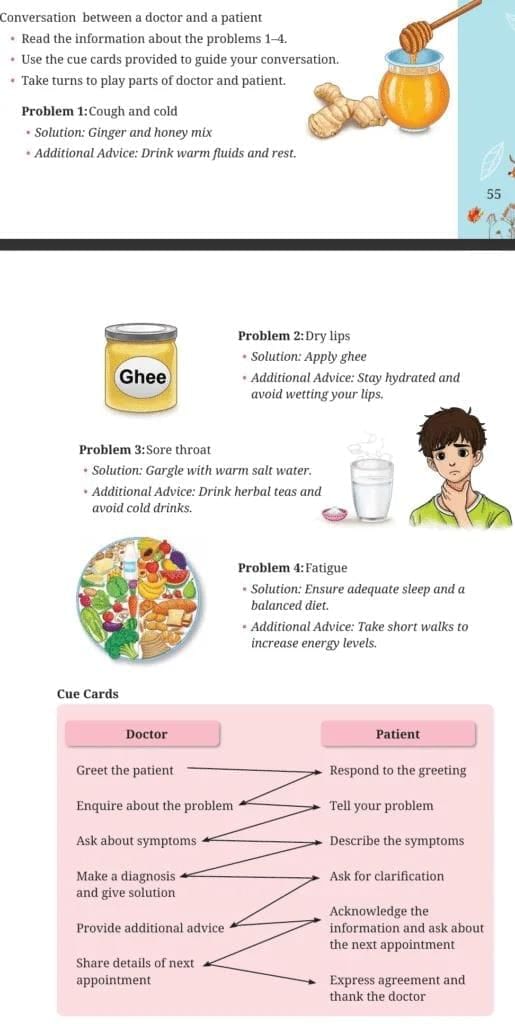
Ans: To help students we are giving here sample conversations based on the cue cards on every problem given in the question.
- Problem 1: Cough and cold,
- Problem 2: Dry lips
- Problem 3: Sore throat
- Problem 4: Fatigue
Doctor–Patient Conversation:
Problem 1: Cough and Cold
Doctor: Good morning!
Patient: Good morning, doctor.
Doctor: How can I help you today?
Patient: I have a bad cough and cold since yesterday.
Doctor: I see. Can you tell me more about your symptoms?
Patient: I have a blocked nose and I keep sneezing. I feel tired too.
Doctor: It seems like a cough and cold. I suggest you take a mix of ginger and honey.
Patient: Okay, doctor. Can you tell me how to take it?
Doctor: Take one spoon of the ginger and honey mix twice a day. Also, drink warm fluids and get plenty of rest.
Patient: Thank you, doctor. That sounds helpful. When should I come for the next check-up?
Doctor: If you don’t feel better in three days, visit me again.
Patient: Alright, doctor. Thank you very much!
Problem 2: Dry Lips
Doctor: Hello! How are you today?
Patient: Hello, doctor. My lips are very dry and rough.
Doctor: Hmm. Do you drink enough water every day?
Patient: Not really. I often forget to drink water.
Doctor: You should stay hydrated. For now, apply some ghee on your lips.
Patient: Okay, doctor. Can I apply it more than once a day?
Doctor: Yes, apply it 2–3 times a day. Also, avoid licking or wetting your lips.
Patient: Got it. When should I come again?
Doctor: If it doesn’t get better in 2 days, come back.
Patient: Thank you, doctor!
Problem 3: Sore Throat
Doctor: Good morning! What brings you here?
Patient: Good morning. My throat hurts when I swallow.
Doctor: Do you also have a cold or fever?
Patient: No, just pain in my throat.
Doctor: You have a sore throat. Gargle with warm salt water.
Patient: Okay, how many times should I do it?
Doctor: Three times a day. Also, drink herbal teas and avoid cold drinks.
Patient: Thank you, doctor. That’s easy to follow.
Doctor: Come back if it doesn’t improve in 2 days.
Patient: Sure, thank you!
Problem 4: Fatigue (Feeling tired)
Doctor: Hello! What seems to be the problem?
Patient: Hello, doctor. I feel tired all the time.
Doctor: Are you sleeping well at night?
Patient: Not really. I sleep late and wake up tired.
Doctor: You may be tired because of less sleep. Eat healthy food and sleep on time.
Patient: Okay, I’ll try. What else can I do?
Doctor: Take short walks during the day. It will help you feel fresh.
Patient: Thank you. That’s very helpful.
Doctor: Visit again if you still feel tired after a week.
Patient: Sure, doctor. Thanks a lot!
Let us write (Page 57)
A notice is a means of formal communication for a particular group ofpersons. It informs them about some important event, such as an invitationto a meeting, an announcement, to give instructions, make appeals, etc.
Write a notice in about 50 words about the Annual Health Check-up forstudents of Grades 6–8. Remind students to collect their health check-upcards from the class teacher. Include all other necessary details about date,time, and venue.
Complete the draft of the notice by using the words and phrases given in the box below.
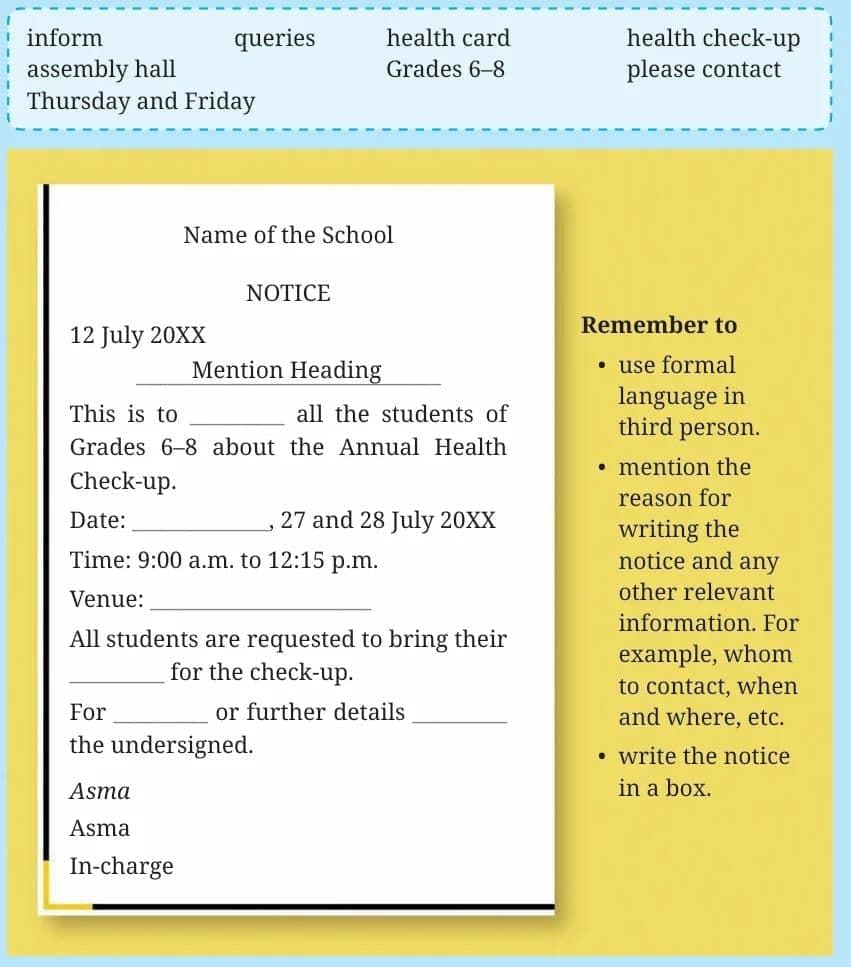
Ans:
Name of the School
NOTICE
12 July 20XX
Annual Health Check-up
This is to inform all the students of Grades 6-8 about the Annual Health Check-up.
Date: 27 and 28 July 20XX
Time: 9:00 a.m. to 12:15 p.m.
Venue: Assembly hall
All students are requested to bring their health card for the check-up. For queries or further details, please contact the undersigned.
Asma
In-charge
Let us explore (Page 58)
I) The word ‘goshala’ translates to ‘cowshed’ in English. It is a Sanskrit word that is made up of the words ‘go’, which means ‘cow’, and śālā, which means ‘shed’ or ‘hall’.
Plan a visit with the teacher to a ‘goshala’ and find out how the cows are looked after
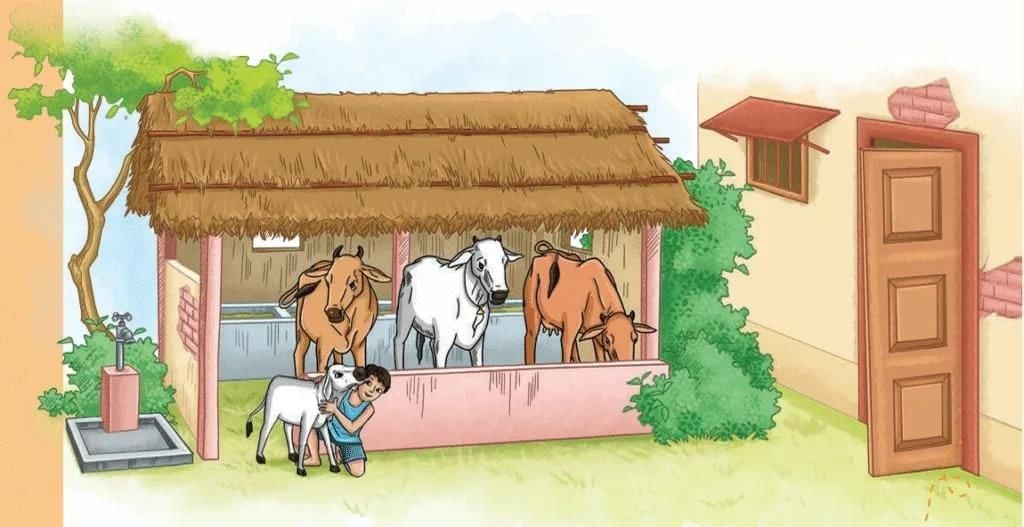
Ans:
This is an activity that students need to do themselves. Here are a few suggestions:
Activity Suggestion for Children:
Plan a visit to a goshala with your teacher. When you go there, observe:
- How cows are fed and given water
- Where they sleep
- How they are cleaned
- Talk to the workers—ask how often cows are milked and checked by a vet.
- If any cows are old or sick, how are they treated
- Do a diary entry about your visit to the goshala.
II) Ayurveda is the oldest existing medical system in India. Animals received good medicinal care in ancient India. Indian medical treatises like Charaka Samhita, Sushruta Samhita, and Harita Samhita contain references of care of animals. Find out names of different organisations that work for the welfare of animals with the help of the teacher.
Ans: Ayurveda is the oldest medical system in India. It not only helped humans but also cared for animals. Ancient Indian medical books like Charaka Samhita, Sushruta Samhita, and Harita Samhita mention how animals were treated and cared for.
Different organisations working for animal welfare today include:
People for Animals (PFA)
Blue Cross of India
Animal Welfare Board of India (AWBI)
Society for the Prevention of Cruelty to Animals (SPCA)
WWF India (World Wildlife Fund)
Humane Society International India
These organisations work to protect animals, provide shelter, medical care, and raise awareness about animal rights.
III) What is the best way to take care of stray and abandoned animals?
1. Provide food and water for the animal
2. Take them to an animal shelter
3. Adopt them by taking them home
Give reasons for your responses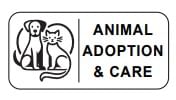
Ans: The best way to take care of stray and abandoned animals
1. Provide food and water
Reason: They stay healthy and strong.
This is easy and helpful. Hungry and thirsty animals suffer a lot. Giving them clean water and some food shows care and kindness.
2. Take them to an animal shelter
Reason: They get medical care and a safe place to live.
A shelter can give medical help, safety, and love. It’s a good place for animals who have no home.
3. Adopt them
Reason: They become part of your family and receive love.
This is the best way if you and your family can take care of a pet. They will get a loving home forever.
|
55 videos|468 docs|76 tests
|
FAQs on NCERT Solutions for Class 7 English Unit 2 Animals, Birds, and Dr. Dolittle
| 1. What are the main themes explored in the article "Animals, Birds, and Dr. Dolittle"? |  |
| 2. Who is Dr. Dolittle and what makes him unique? |  |
| 3. How does the story of Dr. Dolittle reflect the importance of animal welfare? |  |
| 4. What activities are suggested in the article to engage with the themes of the story? |  |
| 5. How can readers apply the lessons from Dr. Dolittle's story to their everyday lives? |  |

















